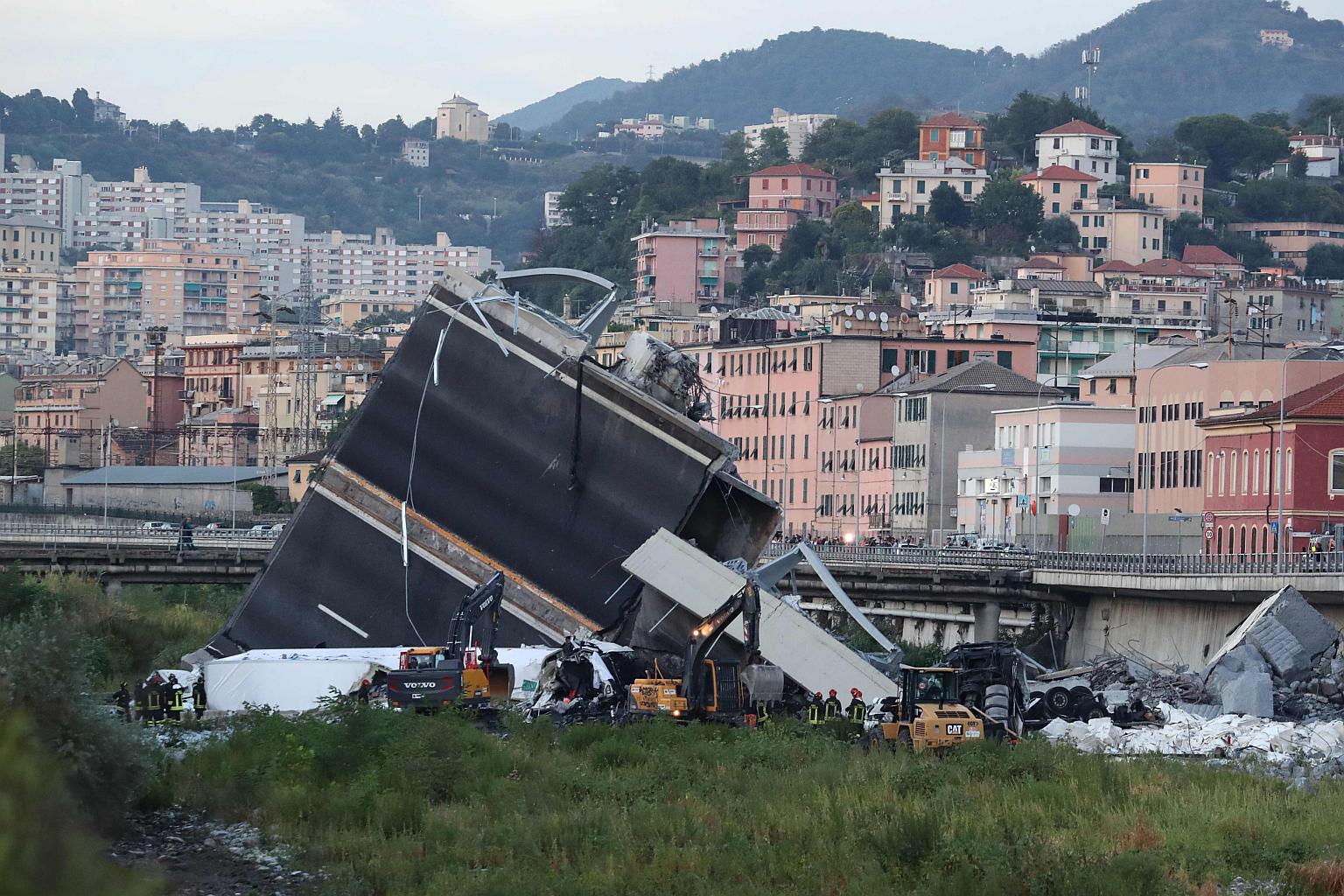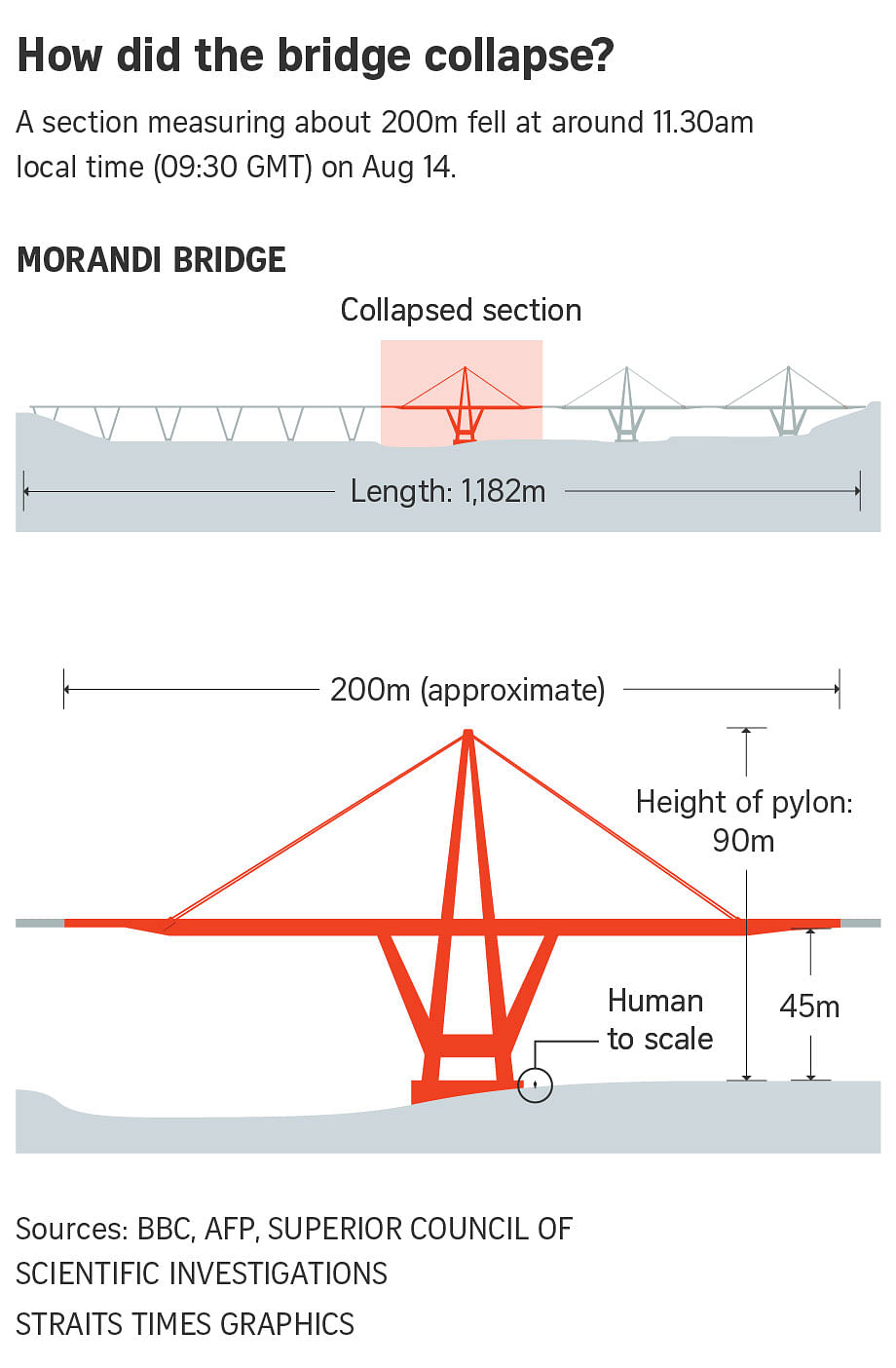Was Italy's motorway collapse a disaster 'waiting to happen'? A look at some plausible causes
Sign up now: Get ST's newsletters delivered to your inbox

Rescuers inspect the rubble and wreckage by the Morandi motorway bridge after a section collapsed in Genoa, on Aug 14, 2018.
PHOTO: AFP
Follow topic:
ROME - A 200m portion of Italy's Morandi motorway bridge collapsed on Tuesday (Aug 14), killing more than 30 people.
While engineering experts agree that a thorough specialist investigation is needed to determine the real causes of the collapse in the Italian city of Genoa, several explanations have been reported.
Here's a look at some plausible factors which could have contributed to Tuesday's disaster.
STRUCTURAL AND DESIGN FLAWS?
The Morandi bridge was built between 1963 and 1967. It has a maximum span of 219 m, a total length of 1.18 km, concrete piers (vertical structures that support the arches of a bridge) that reach 90 m in height.
The technology of pre-stressed reinforced concrete used in the construction was the hallmark of its designer, the celebrated Italian engineer Riccardo Morandi, who died in 1989.
Dubbed patent "Morandi M5", he had used the technology for other works, including a wing of the Verona Arena in 1953.
This technique also characterises another, even longer and just as problematic Morandi bridge: the 8.7-km long General Rafael Urdaneta Bridge that spans the bay of Maracaibo, Venezuela, and was completed in 1962.
That bridge "has also experienced problems during its life, so it could be that the design implies a need for a greater degree of maintenance than normal", Ian Firth, a structural engineer specialising in bridges, told BBC News.
On Tuesday specialist engineering website "Ingegneri.info" published a piece that highlighted how the Morandi bridge had always presented "structural doubts", calling it "a tragedy waiting to happen".
Lending support to the website was Antonio Brencich, a professor of reinforced concrete construction at the University of Genoa, highlighting the constant maintenance the bridge needed.
"It was affected by extremely serious corrosion problems linked to the technology that was used (in construction). Morandi wanted to use a technology that he had patented that was no longer used afterwards and that showed itself to be a failure," said Brencich to Radio Capitale.
Brencich has long been a critic of the bridge.
He said the designer, Riccardo Morandi, had miscalculated how reinforced concrete ages. "He was an engineer with great insight, but lacking in practical calculations", he was quoted as saying by BBC News.
In 2016 he spoke with "Ingegneri.info" about construction going over budget and poor calculations over concrete viscosity that led to an uneven road surface which wasn't fully corrected until the 1980s.

ITALY'S AGEING INFRASTRUCTURE
In a phone interview, Antonio Occhiuzzi, director of the Institute for Construction Technology for Italy's National Research Council, told New York Times most of the nation's infrastructure "needs to be carefully re-examined" because much "was at the end" of its useful life span"
The collapse of the Genovese bridge was a serious alarm, he said, "because it is not an isolated case - in the last three years, a number of bridges have collapsed in Italy, and they are all around 50 years old".
The Morandi viaduct, less than five km to the west of Genoa's old port, was built in the 1960s and completed in 1967.
"Fifty years ago, we had unlimited confidence in reinforced concrete, we thought it was eternal, but now we know that it only lasted a few decades," Diego Zoppi, former president of the Genoa branch of the order of architects, told reporters on Tuesday.
Zoppi warns that it is impossible that similar tragedies won't happen again without serious work on infrastructure built post-World War II.
"The Italy built in the 1950s and 1960s is in urgent need of renovation. The risk of collapses is underestimated, the works built at that time are coming to an age when they are at risk."
BAD WEATHER
Regional weather services had issued a storm warning for the morning of the collapse and the national police force said on Twitter the disaster happened amid a "violent cloudburst".
The national police noted that there was a "violent cloudburst" about the time the section fell.
Some witnesses said the bridge was struck by lightning just before it collapsed, though it was not clear whether the storm contributed to the failure.
But Edoardo Rixi, the deputy transportation minister, said that the bridge had shown some "signs of problems" in the past.
"A bridge like that doesn't collapse because of a lightning bolt, or a storm," he said
HEAVY TRAFFIC
Normally, a bridge is designed to last for at least 100 years, according to BBC News.
Heavy usage of the motorway bridge, which sits on a major artery, the A10, serving the Italian Riviera and linking northern Italy to France, could have accelerated its degradation.
Around 25 million vehicles use the Morandi bridge every year.
A 2011 report by Italian highways company Autostrade per l'Italia said that the bridge had been suffering from degradation.
The "queues of cars and the volume of traffic provoke intense degradation of the bridge structure on a daily basis in rush hour, as it is subject to major demands", the report, quoted by Italian news agency Ansa, said.
"The collapse could have been influenced by the consequences of increases in heavy traffic and the punishing treatment the motorway got. It was heavily used, there is no question about that," Ian Firth, past president of the UK-based Institution of Structural Engineers, told BBC News.
MAINTENANCE ISSUE?
"In the sad history of bridge collapses, maintenance has sometimes been a factor, if it is poorly planned or implemented," Ian Firth, past president of the UK-based Institution of Structural Engineers, told BBC News.
"A major bridge like this needs regular inspection and maintenance by qualified engineers. This bridge has had quite a lot of maintenance work," he said.
Economic news agency Radiocor reports that Italy's motorway agency had recently launched a 20-million-euro tender for work on the viaduct.
The tender provided for a strengthening of the bridge's pier cables, including those of pier nine, the one that collapsed on Tuesday.
Notwithstanding the importance of a road that sees 25 million vehicles pass along it every year, the demolition of the bridge was being studied as far back as 2009.
Specialist engineering website "Ingegneri.info" says that bridges like the Morandi viaduct should have a lifespan of at least a century, but the structure has been the subject of major maintenance work in the years after its completion, in particular to repair cracks and combat degradation of the concrete.
In the early 2000s the suspension cables put in place in the 1980s and 1990s were replaced.
"Some maintenance intervention appears to have been going on at the time, but we don't know the details so it is not possible to say whether this could have been a factor (in the collapse)," he told BBC News.
Autostrade, a highway operator controlled by Atlantia which runs much of Italy's motorway network, said it had been carrying out maintenance work on the bridge. Shares in Atlantia plunged on the Milan stock exchange after the collapse.
SOURCES: AGENCE FRANCE-PRESSE, BBC NEWS, NYTIMES

